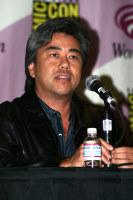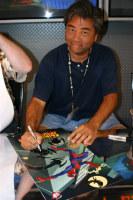|

MAIN • CHARACTERS • EPISODES • MEDIA • REVIEWS • INTERVIEWS • RELEASES • FORUM
INTERVIEWS
 Can
you tell us a bit about yourself and how you got started
in the business? Can
you tell us a bit about yourself and how you got started
in the business?
I am married and have a daughter and son. I grew up an
Air Force brat going to schools in Texas, Florida and
California, as well as Kadena Air Force Base in Okinawa,
Japan. Because of that I was exposed to both American
and Japanese animated programs from a young age -- as
well as collecting Marvel, DC comics and big telephone
book thick Manga.
Although I grew up a comic and animation fan, I was
focused on comic strips and political cartooning while
drawing for the campus newspaper when I attended Cal
State Long Beach. A college art teacher put me in
contact with a former student who had gone into
animation and that meeting rekindled my interest in
animation. I called Filmation Studios to see if they had
any openings, and they tested me and hired me the next
week as an in-betweener on Brave Starr. Later I started
storyboarding at Walt Disney TV Animation, where I
eventually had the opportunity to work as a Director on
many series such as “Buzz Lightyear of Star Command,”
“The Legend of Tarzan,” and the “Atlantis” direct-to
DVD. I also served as a Producer/Director of “Lilo &
Stitch: The Series.” In 2006, I left Disney to direct
“Hellboy: Blood and Iron.”
The Spider-Man Animated Series features Peter as a
modern-day teenager. Will Peter work on stories dealing
with the real issues kids face today like drugs,
violence, and sex?
Peter will definitely deal with many issues kids deal
with today, such as finding a date for the school dance,
keeping up with studies while holding down a part time
job, dealing with bullies and navigating the social
cliques of the modern day high school. He is also
dealing with some unreal issues such as keeping New York
safe from super villains!
Will the stories be loosely based on
previously-established comic book stories, or will they
be created from scratch?
These are new scripts that use the classic characters.
Greg Weisman and the writers are contemporizing that
exciting time of Peter’s life when he first became
Spider-Man from the classic Lee/Ditko era.
Do you plan to use story arcs throughout the season,
or will each episode stand alone?
BOTH! The episodes can be viewed and enjoyed as stand
alone stories. But there are also connective storylines
that thread over the course of the season.
 Will we see guest stars from the Marvel Universe,
such as the Avengers, Fantastic Four, or the X-Men? Will
the Punisher make an appearance? Will we see guest stars from the Marvel Universe,
such as the Avengers, Fantastic Four, or the X-Men? Will
the Punisher make an appearance?
Not in the first season, which spans 13 episodes. But
we’re working on second season now and, providing the
show goes on for numerous season, we'll see how things
progress.
In your opinion, what will set this series apart from
other Spider-Man cartoons?
The stories, the look and the filmmaking style. Great
characterization, plot and action. The stories play as
episodes, but also arc over the season. The characters
and backgrounds are designed for animation, not the
printed page. This will be an action show with classic
animation squash and stretch. This will be a Spider-Man
that moves! It’s also very cinematic with an
East-meets-West filmmaking sensibility. Action scenes
are choreographed with a bit of a Hong Kong flair. The
pacing, the staging and the color selections are all to
chosen to enhance the storytelling.
You have worked on comic adaptations and original
animated productions before. How does your approach
differ with these two sources?
From a directing standpoint it's all filmmaking. The
approach depends on the genre and the material. On an
original idea, you can make up the rules of your
universe and create your own mythology. On a comic
adaptation, there are already decades of mythology to
work with. The fun and challenge is how to present that
in a new, fresh and exciting way.
How did you choose the animated style for this
series?
I wanted an action show with classic squash and stretch.
I knew the staging, acting and action was going to be
cinematic, but I also wanted it to be fun. While it's
not going to be "cartoony," I didn't want realistic
stiff mannequins walking around. Sometimes the acting is
very live action and naturalistic and other times it’s a
bit broad. It has been very satisfying being able to
determine the look and filmmaking style of this series.
Fortunately, everyone involved on this project is on the
same page in wanting to have a fresh visual approach. We
all wanted a stylized, sleek animatable look with strong
silhouettes. Spider-Man is about speed and movement, so
the style had to be free of cluttered detail. It had to
be great to look at and be fast and easy for the
animators to draw. Because the show centered on Peter's
high school years, I also wanted the designs to be fun.
The man on the street in the background should be as
interesting to look at as Spider-Man or our villains.
Sean "Cheeks" Galloway was the concept designer on
“Hellboy: Blood and Iron,” which I directed. His
concepts had an appealing, simplified look that I felt
would be perfect for Spider-Man. ASean did some
development art on Spider-Man, and we all agreed to
bring him on the show. I also wanted the background
style to be simplified with strong silhouettes. The
backgrounds will have architectural touches and at the
same time a lack of detail. We are keeping lines as part
of our final painted look. This also allows for three
dimensional camera moves and animating backgrounds to
match the look of the rest of our non-moving
backgrounds. The paintings are somewhat graphic without
that air-brushy look.
 What is it like to work on a series that has such an
extensive background? What is it like to work on a series that has such an
extensive background?
With great power comes great responsibility! It's a lot
of fun and a lot of hard work. It's also a bit surreal.
I grew up on Spider-Man comics, and I watched the
original animated series and ran around the house
singing it's theme song as a kid. Now I get to make a
Spider-Man show for the next generation. It doesn't get
much better than that.
What preparations did you make when approaching this
series?
In a way our crew has been preparing for this since our
childhoods. We all grew up comic book fans and
especially Spider-Man fans. Other than that, we have
been re-reading and studying the Lee/Ditko era
Spider-Man comics. Greg Weisman and the writers have a
goal of not creating any new characters, but using the
characters that Lee and Ditko created and contemporizing
them. Those early comics are also visual inspiration for
the design and storyboard crew as well. Like the early
comics, we didn't want our Spider-Man to be some big
muscle bound he-man – I am very happy our design for the
show follows that thinking. Those early comics are also
inspiration for us in terms of the character poses and
some really great iconic imagery.
Villains are an important part of a series like this.
How much character development can we expect to see with
Spidey¹s foes?
Very much. We will get to know these villains and what
motivates them. These characters evolve over multiple
episodes, and the audience will get to know many of them
before they become super villains.
The Marvel Animation Age would like to thank Vic for his participation in this interview, and his work on the show.
Cheers Vic!

|